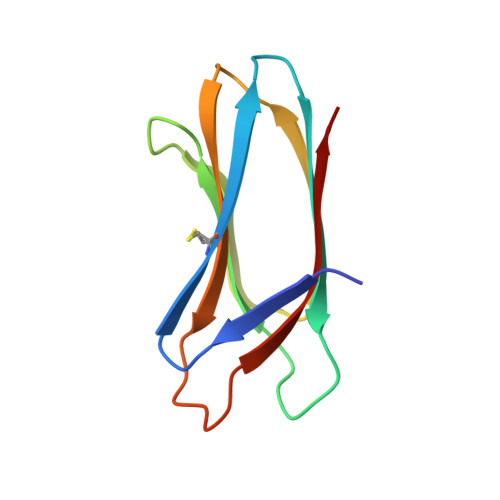3D Structure and Interaction of p24 beta and p24 delta Golgi Dynamics Domains: Implication for p24 Complex Formation and Cargo Transport
Nagae, M., Hirata, T., Morita-Matsumoto, K., Theiler, R., Fujita, M., Kinoshita, T., Yamaguchi, Y.(2016) J Mol Biology 428: 4087-4099
- PubMed: 27569046
- DOI: https://doi.org/10.1016/j.jmb.2016.08.023
- Primary Citation of Related Structures:
5AZW, 5AZX, 5AZY - PubMed Abstract:
The p24 family consists of four subfamilies (p24α, p24β, p24γ, and p24δ), and the proteins are thought to form hetero-oligomeric complexes for efficient transport of cargo proteins from the endoplasmic reticulum to the Golgi apparatus. The proteins possess a conserved luminal Golgi dynamics (GOLD) domain, whose functions are largely unknown. Here, we present structural and biochemical studies of p24β1 and p24δ1 GOLD domains. Use of GOLD domain-deleted mutants revealed that the GOLD domain of p24δ1 is required for proper p24 hetero-oligomeric complex formation and efficient transport of GPI-anchored proteins. The p24β1 and p24δ1 GOLD domains share a common β-sandwich fold with a characteristic intrasheet disulfide bond. The GOLD domain of p24δ1 crystallized as dimers, allowing the analysis of a homophilic interaction site. Surface plasmon resonance and solution NMR analyses revealed that p24β1 and p24δ1 GOLD domains interact weakly (K d = ~10 -4 M). Bi-protein titration provided interaction site maps. We propose that the heterophilic interaction of p24 GOLD domains contributes to the formation of the p24 hetero-oligomeric complex and to efficient cargo transport.
- Structural Glycobiology Team, Systems Glycobiology Research Group, RIKEN-Max Planck Joint Research Center, RIKEN Global Research Cluster, 2-1 Hirosawa, Wako City, Saitama 351-0198, Japan.
Organizational Affiliation:

















